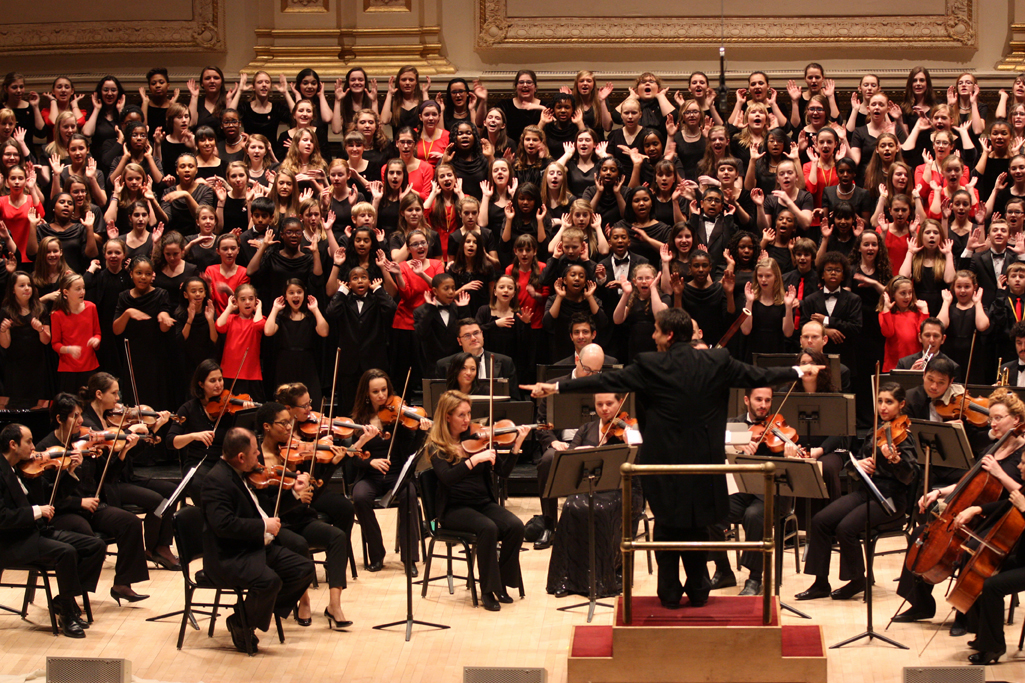The Sounds of War and Peace (DCINY): Chapter 1 in Review
Distinguished Concerts International New York (DCINY) The Sounds of War and Peace: Chapter 1 Distinguished Concerts Orchestra, Distinguished Concerts Singers International Francisco J. Núñez, composer/conductor; Jonathan Willcocks, composer/conductor Stern Auditorium, Carnegie Hall; New York, NY January 20, 2013Distinguished Concerts International New York (DCINY), well-known for themed programs, created a concert series called “The Sounds of War and Peace”. Over two nights, each “chapter” focuses on music that expresses not only the horrors of war and its aftermath, but also the idea of peace through the idea of multi-cultural understanding and cooperation. On January 20, 2013, Chapter 1 was performed- the first half “peace”, and after intermission, “war”.
The first half, featuring elementary and middle school-aged performers from Georgia, Connecticut, Texas, Pennsylvania, and Maryland was conducted by the multi-talented Francisco J. Núñez. Billed in the program as “Music for Future Peacemakers”, it was a selection of works that could be best described as having the qualities of child-like innocence, rather than having any more overt “peace “message. It was more William Blake than Mohandas Gandhi. Opening with Kayama from Adiemus: Songs of Sanctuary by Karl Jenkins, the night got off to a good start. One of Jenkins’ earlier works, it already incorporates many elements of what could be called his signature sound – an easily sung melody combined with the flavor of diverse multi-cultural influences, especially in percussion and rhythm. The “words” of this piece are invented and are not part of any recognizable language, lending it what the program notes described as a “tribal” sound. It was given a joyful performance. Dôme épais, better known as the “Flower duet”, from Leo Delibes’ Lakmé followed. The soprano and mezzo-soprano soloists (whose names were not mentioned) sang this favorite with polish in an arrangement by Núñez. The chorus was challenged by the some of the upper register sections, not at all surprising considering the age of the performers. It did seem to be a curious selection that did not really fit in with the other works or the theme of the concert itself. Three Dominican Folk Songs, as arranged by Núñez, captured the essence of nursery songs. From the playful, to the poignant, and even to the mocking, the young performers brought it all to life. After this whimsy, a more serious selection was in order, and selections from Misa Pequeña Para Niños (A Children’s Mass) fulfilled this. Composed by Núñez in memory of his father, it is a fitting tribute written by a composer who has a great understanding of the limitations and possibilities of the child’s voice. The three selected movements were rendered with great feeling and in conjunction with the “big sound” of the orchestra elicited from the young performers a collective sound beyond their years. The remaining selections brought back the spirit of joy and hope. The polyrhythmic clapping in Aaron Siegel’s The Light Come Down was a highlight of the evening and brought the crowd’s roaring approval. Sesere Eeye, complete with hands waving, jumps, and leaning forward, was the signal that the fun was back, which continued in Oye by Jim Papoulis. Even Núñez got into the act, dancing at the podium while the singers spun around in their own dance, reminiscent of Gustavo Dudamel with the Simón Bolívar Youth Orchestra. Ending with the anthem-like Give Us Hope from Papoulis, the hearts of the audience were won over completely. It was truly touching to see the smiles and excitement on the faces of the young performers – a memory that will be with them always.
The adults took to the stage for the “war” second half- the Carnegie Hall premier of A Great and Glorious Victory, conducted by the work’s composer Jonathan Willcocks. This work was commissioned to mark the bicentenary of the Battle of Trafalgar. Scored for tenor soloist, chorus and orchestra mirroring Haydn in his Nelson Mass, the four movements use words from the Latin Requiem Mass, the Book of Common Prayer, and contemporary accounts of the events, including Nelson’s.
This four- movement work not only commemorates the well-known battle and it’s most famous personality, Admiral Nelson, but a much lesser-known event that occurred after the battle. A terrible storm after the battle had finished threatened all the combatants and in the spirit of cooperation and brotherhood, they put their differences aside and aided the others regardless of nationality.
The first movement, Preparation, is a solemn prelude to the coming battle. One can feel the rising tensions as there are prayers for strength and hope of victory. The second, Conflict, has the chorus singing the Dies Irae while the tenor soloist is singing the words of Nelson at the same time. It was an inspired idea that highlighted the idea of battle. Eventually, the battle slows and the Lacrymosa quietly ends the movement. Storm, the third movement, featured the tenor soloist singing off-stage (in this case, in the balcony) from the Book of Common Prayer asking for deliverance from the terrible storm. Finally, the last movement, Reconciliation, highlights the ideal of a new peace, where the former enemies cast aside their differences. It ends with the tenor soloist singing off-stage while his voice fades to silence. The composer refers to this movement as the heart of the work.
Willcocks proved to be an effective and engaging conductor, while tenor soloist Daniel Shirley’s voice soared over the large forces with strength and clarity. The DCINY orchestra played with intensity and brought out both the savage and the sublime. The large chorus was well prepared and sang with great fervor and passion. A Great and Glorious Victory wasn’t composed with DCINY in mind, but it is a work they could make their own. It was a memorable performance.

